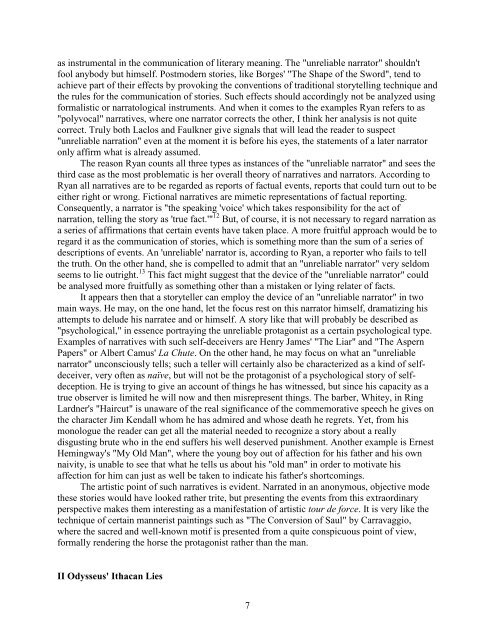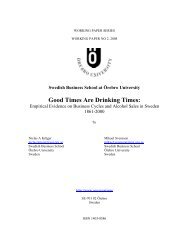Stories in Disguise: On Odysseus' Ithacan Lies and Their Relevance ...
Stories in Disguise: On Odysseus' Ithacan Lies and Their Relevance ...
Stories in Disguise: On Odysseus' Ithacan Lies and Their Relevance ...
You also want an ePaper? Increase the reach of your titles
YUMPU automatically turns print PDFs into web optimized ePapers that Google loves.
as <strong>in</strong>strumental <strong>in</strong> the communication of literary mean<strong>in</strong>g. The "unreliable narrator" shouldn't<br />
fool anybody but himself. Postmodern stories, like Borges' "The Shape of the Sword", tend to<br />
achieve part of their effects by provok<strong>in</strong>g the conventions of traditional storytell<strong>in</strong>g technique <strong>and</strong><br />
the rules for the communication of stories. Such effects should accord<strong>in</strong>gly not be analyzed us<strong>in</strong>g<br />
formalistic or narratological <strong>in</strong>struments. And when it comes to the examples Ryan refers to as<br />
"polyvocal" narratives, where one narrator corrects the other, I th<strong>in</strong>k her analysis is not quite<br />
correct. Truly both Laclos <strong>and</strong> Faulkner give signals that will lead the reader to suspect<br />
"unreliable narration" even at the moment it is before his eyes, the statements of a later narrator<br />
only affirm what is already assumed.<br />
The reason Ryan counts all three types as <strong>in</strong>stances of the "unreliable narrator" <strong>and</strong> sees the<br />
third case as the most problematic is her overall theory of narratives <strong>and</strong> narrators. Accord<strong>in</strong>g to<br />
Ryan all narratives are to be regarded as reports of factual events, reports that could turn out to be<br />
either right or wrong. Fictional narratives are mimetic representations of factual report<strong>in</strong>g.<br />
Consequently, a narrator is "the speak<strong>in</strong>g 'voice' which takes responsibility for the act of<br />
narration, tell<strong>in</strong>g the story as 'true fact.'" 12 But, of course, it is not necessary to regard narration as<br />
a series of affirmations that certa<strong>in</strong> events have taken place. A more fruitful approach would be to<br />
regard it as the communication of stories, which is someth<strong>in</strong>g more than the sum of a series of<br />
descriptions of events. An 'unreliable' narrator is, accord<strong>in</strong>g to Ryan, a reporter who fails to tell<br />
the truth. <strong>On</strong> the other h<strong>and</strong>, she is compelled to admit that an "unreliable narrator" very seldom<br />
seems to lie outright. 13 This fact might suggest that the device of the "unreliable narrator" could<br />
be analysed more fruitfully as someth<strong>in</strong>g other than a mistaken or ly<strong>in</strong>g relater of facts.<br />
It appears then that a storyteller can employ the device of an "unreliable narrator" <strong>in</strong> two<br />
ma<strong>in</strong> ways. He may, on the one h<strong>and</strong>, let the focus rest on this narrator himself, dramatiz<strong>in</strong>g his<br />
attempts to delude his narratee <strong>and</strong> or himself. A story like that will probably be described as<br />
"psychological," <strong>in</strong> essence portray<strong>in</strong>g the unreliable protagonist as a certa<strong>in</strong> psychological type.<br />
Examples of narratives with such self-deceivers are Henry James' "The Liar" <strong>and</strong> "The Aspern<br />
Papers" or Albert Camus' La Chute. <strong>On</strong> the other h<strong>and</strong>, he may focus on what an "unreliable<br />
narrator" unconsciously tells; such a teller will certa<strong>in</strong>ly also be characterized as a k<strong>in</strong>d of selfdeceiver,<br />
very often as naïve, but will not be the protagonist of a psychological story of selfdeception.<br />
He is try<strong>in</strong>g to give an account of th<strong>in</strong>gs he has witnessed, but s<strong>in</strong>ce his capacity as a<br />
true observer is limited he will now <strong>and</strong> then misrepresent th<strong>in</strong>gs. The barber, Whitey, <strong>in</strong> R<strong>in</strong>g<br />
Lardner's "Haircut" is unaware of the real significance of the commemorative speech he gives on<br />
the character Jim Kendall whom he has admired <strong>and</strong> whose death he regrets. Yet, from his<br />
monologue the reader can get all the material needed to recognize a story about a really<br />
disgust<strong>in</strong>g brute who <strong>in</strong> the end suffers his well deserved punishment. Another example is Ernest<br />
Hem<strong>in</strong>gway's "My Old Man", where the young boy out of affection for his father <strong>and</strong> his own<br />
naivity, is unable to see that what he tells us about his "old man" <strong>in</strong> order to motivate his<br />
affection for him can just as well be taken to <strong>in</strong>dicate his father's shortcom<strong>in</strong>gs.<br />
The artistic po<strong>in</strong>t of such narratives is evident. Narrated <strong>in</strong> an anonymous, objective mode<br />
these stories would have looked rather trite, but present<strong>in</strong>g the events from this extraord<strong>in</strong>ary<br />
perspective makes them <strong>in</strong>terest<strong>in</strong>g as a manifestation of artistic tour de force. It is very like the<br />
technique of certa<strong>in</strong> mannerist pa<strong>in</strong>t<strong>in</strong>gs such as "The Conversion of Saul" by Carravaggio,<br />
where the sacred <strong>and</strong> well-known motif is presented from a quite conspicuous po<strong>in</strong>t of view,<br />
formally render<strong>in</strong>g the horse the protagonist rather than the man.<br />
II <strong>Odysseus'</strong> <strong>Ithacan</strong> <strong>Lies</strong><br />
7

















